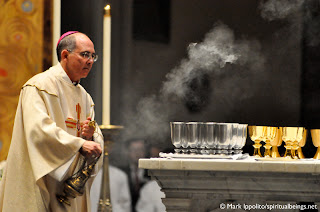Dozens of priests dressed in white full-length robes, framed in bright red silk scarves, surrounded the perimeter of the cathedral entrance providing the first visible evidence of the high ceremony about to begin. While predominantly middle to late- middle age, I was struck by the fairly high percentage of younger priests who were among them. While undoubtedly the number of young men who are dedicating their lives to the priesthood has declined over the years, I was impressed at the continuing allure the priesthood holds for some young men.
After a convivial moment of shared smiles and conversation among colleagues gathered on the sidewalk, the priests formed a procession and slowly began to enter the church in pairs. The clergy were followed by the Order of Malta, a lay ministry dedicated to medical and humanitarian activities whose formation dates to 1048. The Order’s Western Association provides financial and volunteer support for multiple programs in Seattle ranging from homeless advocacy, food distribution and counseling.
The ornately dressed Knights of Columbus took their place next and closed the procession. While I was familiar with the Knights as a Catholic fraternal organization whose members conduct fundraising for community service programs, I had never witnessed their participation as dignitaries in a church event. Each “knight” wore a tricorn hat festooned with large feathered plumes, which neatly complemented their militaristic garb. Outfitted as they were, and given the lack of any visible security personnel, whether intended or not, the Knights took on the appearance of protectors and guardians of the event. Again, among their numbers I was struck at the number of young men in their 20’s and 30’s who participated in the ceremony suggesting at least on this day that a traditional Catholic social organization continues to attract new members.
The ornately dressed Knights of Columbus took their place next and closed the procession. While I was familiar with the Knights as a Catholic fraternal organization whose members conduct fundraising for community service programs, I had never witnessed their participation as dignitaries in a church event. Each “knight” wore a tricorn hat festooned with large feathered plumes, which neatly complemented their militaristic garb. Outfitted as they were, and given the lack of any visible security personnel, whether intended or not, the Knights took on the appearance of protectors and guardians of the event. Again, among their numbers I was struck at the number of young men in their 20’s and 30’s who participated in the ceremony suggesting at least on this day that a traditional Catholic social organization continues to attract new members.
 Following the procession inside, the large cathedral was now packed with several thousand parishioners. All pews and side rows as well as the areas to the side and behind the center altar were full to capacity. I took position nearest the altar where I could best view both the installation and the reaction of the attendees. After a series of songs and prayers, Sartain took the pulpit to deliver his homily. His message placed urgency on the church’s need to connect and remain a relevant presence with people of all nationalities and cultures. To emphasize this point he delivered his homily in both English and Spanish adding credibility to his remarks.
Following the procession inside, the large cathedral was now packed with several thousand parishioners. All pews and side rows as well as the areas to the side and behind the center altar were full to capacity. I took position nearest the altar where I could best view both the installation and the reaction of the attendees. After a series of songs and prayers, Sartain took the pulpit to deliver his homily. His message placed urgency on the church’s need to connect and remain a relevant presence with people of all nationalities and cultures. To emphasize this point he delivered his homily in both English and Spanish adding credibility to his remarks.Once the homily was complete, several speakers approached the pulpit and offered prayers in multiple languages including Vietnamese, Tagalog and Polish, as well as drummers from the Lummi Nation reflecting the many diverse cultures in the Northwest that embrace Catholicism as their spiritual practice.
Surrounded by other bishops and dignitaries, Sartain was presented with his golden staff and, to great applause, officially introduced as the Archbishop of Seattle. In this role Sartain oversees the community of nearly 1 million Catholics and 147 parishes located throughout Western Washington.
In preparation for Holy Communion, the most sacred part of the Mass, dozens of tall silver chalices were set out on the raised altar. Gently swinging a thurible, Sartain approached the altar bathing the sacred space with the smoky, spicy fragrance of incense. Incensing the altar served to highlight the Eucharist as the most sacred element of the worship service. Once the wine and host were blessed a silent choreography was set in motion among the dozens of priests who took host and chalice in hand to serve communion to the assembled worshipers.
The parishioners who stepped forward to take communion, resembled any other large, urban community gathering reflecting a variety of ages, ethnicity and dress. Their presence and active engagement in this special event served to illustrate that while Catholicism may not play a highly visible role in Northwest daily life, clearly, given the outpouring of support for the installation of their new leader, Northwest Catholics are present and accounted for.











